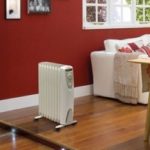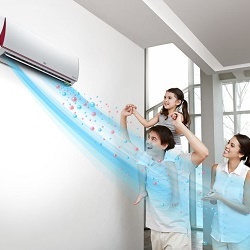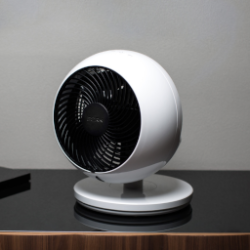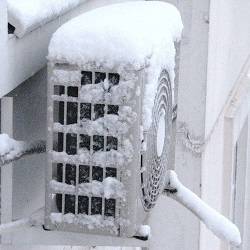Wall-mounted electric convectors with thermostat
With the onset of cold weather, many homeowners began to look for additional heaters to make the room temperature more comfortable. For these purposes, manufacturers produce modern appliances - wall mounted electric convectors heating with thermostat, which quickly heat up almost any room to the optimum set temperature. These heat sources can be used as the main heating, and as an auxiliary - the range in special stores is very impressive. They are cheaper outdoor or floor convectors, for them there is no need to lay pipes or other communications: just plugged into the home network through an outlet and enjoy the heat.
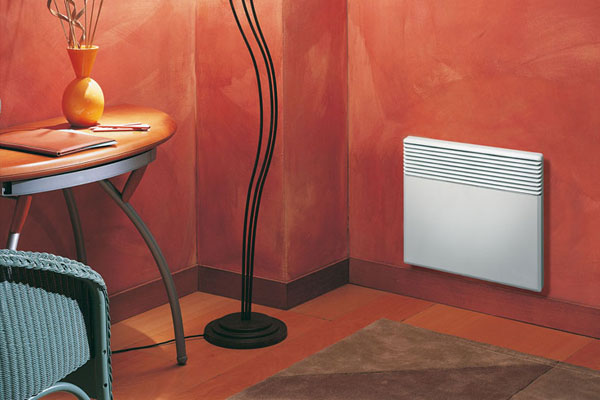
Content
Design features
An electric wall-mounted convector differs from similar heating devices in that it implements the simplest path from the heat source — the product heat exchanger — to the air flow passing through the housing. The design of any such household appliance is extremely simple:
- housing;
- Tena or heat exchanger;
- thermostat.
The process of heat extraction from the heating elements is the following: on the case of the electric convector from the bottom and from the top there are special slotsthrough which the cold air enters, heats up, coming into contact with the heat exchanger, and the warm flow rises through the upper grilles to the ceiling and heats the room (for more details on the action scheme, see the articlehow does electric convector work).
Housing
Wall convectors heating are made in a special way, because one side is constantly in contact with the wall: the cuts on the top always have a direction away from the axis of the body to create a smooth flow of air. Specialists classify the following types of design of the case system of the product:
- hollow body on the basis of a thin sheet steel with enamel coating;
- radiator with stiffeners, TEH are built in.
The first option is the electric convector of the simplest model, where the case serves as an ordinary protection of the heating element or heat exchanger from mechanical damage. Such devices are light, so they are temporarily installed on the wall and dismantled for the summer period.
In the second version, the product is practically no different from an aluminum or rather fashionable bimetallic central heating radiator. The ribs provide more interaction with the air flow. Such products are more economical, and their design is considered by experts to be the best solution for such an installation.
Heat exchanger
From the type of performance are distinguished types of heating elements:
- spiral of nichrome filament, open;
- TEN air type;
- heat exchanger made of steel or aluminum;
- ceramic heaters.
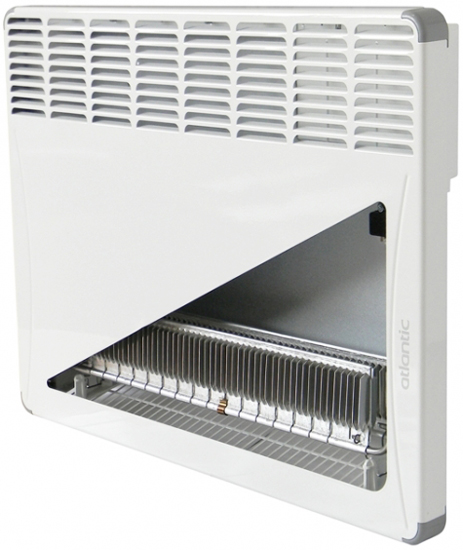
Electric convector heater
From open spirals Modern manufacturers of devices such as electric heating convectors have long since abandoned - they are actively burning out oxygen, and all the dust in the room burns, passing through the convector, releasing harmful substances.No matter how ventilated, there is always an unpleasant smell. Other variants of the spirals differ in different types of airflow insulation, but not all of them are used in the construction of wall-mounted electroconvector.
Heat exchangers made of steel and aluminum are used in a wider range: due to the abundance of ribs and plates contact with the air flow is more dense, the problem of burning oxygen or dust is no longer, since the heating of the case is not so significant.
Ceramic heating elements - it is a solid construction of monolithic heaters with a spiral inside (it is inserted into the molten ceramics). Together with metal heat exchangers, they form an ideal group, which is installed in an electric convector that works in a room where people are constantly located.
The control system, as well as all the functionality of the convector, determines the final cost of the product, therefore, we will discuss the thermostats that turn the product on and off depending on the room temperature.
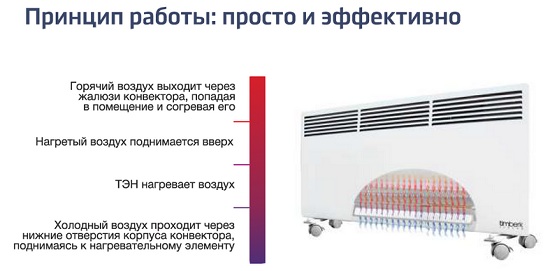
Varieties of thermostats
Temperature regulators are issued electronic and mechanical type. Wall convectors from the leading company in this field, NOBO from Norway, are equipped with diverse thermostats:
- Built-in thermostats of a fixed design implanted into the body of the product during production, they can not be replaced by other types, they are characterized by manual mechanical control.
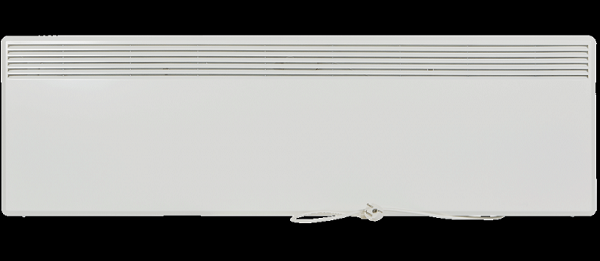
- Removable built-in thermostats have manual adjustment. This thermostat comes with a convector case, but if you wish, users can remove a special fastening ring and install a different type of product. Removable thermal sensor is different in that you can install a specific program to maintain the optimum temperature in the room. Such original buildings of the Norwegian company are sold throughout Russia, and it is easy to acquire them for users of the Russian hinterland.
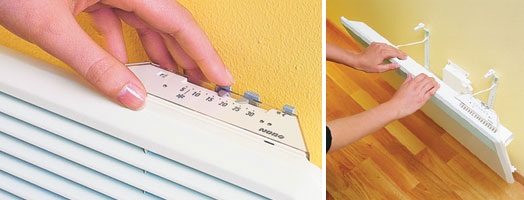
- Built-in thermostats having radio control. The electric convector and these products are sold separately, but the developers have arranged a place for the installation of a thermal sensor in the body of the heating unit. Setting the optimum temperature is done manually, and partly by an automatic control unit, it all depends on the desire of users.You can replace it with a fully automatic mode - for this you need to purchase an automation unit.
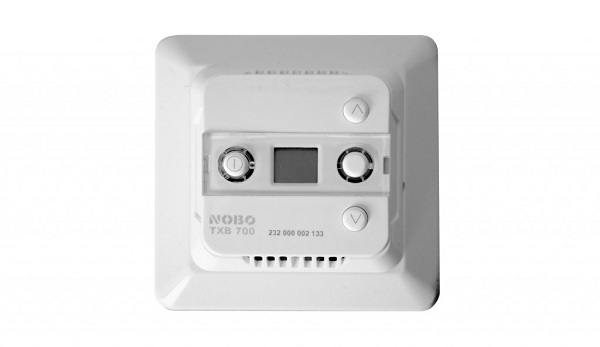 In mechanical-grade thermostats, a plate is installed with a spring that immediately calls into the temperature of the incoming air flow: when cold, the contacts close and the heating of all heating elements or heat exchanger begins, and when warm air enters, the plate expands and the contacts open. The disadvantage is the fact that you will not be able to establish the exact optimal temperature - there is always a variation of up to 5 degrees.
In mechanical-grade thermostats, a plate is installed with a spring that immediately calls into the temperature of the incoming air flow: when cold, the contacts close and the heating of all heating elements or heat exchanger begins, and when warm air enters, the plate expands and the contacts open. The disadvantage is the fact that you will not be able to establish the exact optimal temperature - there is always a variation of up to 5 degrees. - Electronic control units have flexible settings and can control the set temperature with particular accuracy - they react to any temperature change of 0.1 ° C. At the outlet and the heat exchanger, sensors are installed that monitor the temperature of the air flow and the power of the convector. The user can set an acceptable mode of operation and schedule for the day or week. To control multiple convectors in the apartment or in your own home, connect a special controller.
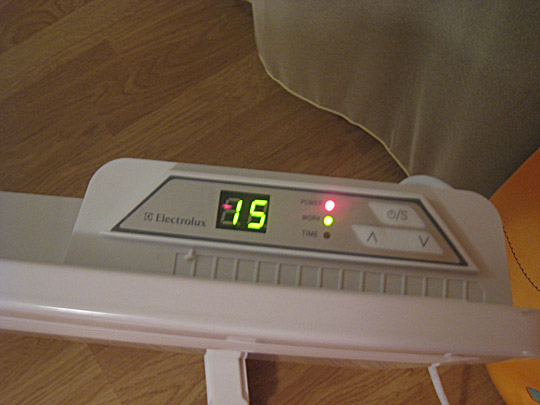
Naturally, the cost of electronically controlled convectors is much higherthan analogs with a mechanical thermostat, but the functionality is much more extensive - a comfortable temperature, remote control allows you to change the modes of operation of the convector.
Modes of operation
Electric heating convectors with electronic type thermostat can have the following modes of operation:
- comfort, economic and automatic;
- anti-freezing, i.e. temperature not below + 5 ° C;
- air ionization - this is the saturation of the air flow with negatively charged ions, this mode also functions when the heat exchanger is off;
- Restart is the ability of electronics to restore all settings after a shutdown;
- protection against overturning (only for floor-standing versions) - the product is turned off instantly, so as not to cause a fire;
- electronic thermostat can set the program for the day or week of work.
Economy Mode allows minimal use of electricity when comfort mode the power consumption mode is slightly increased, and users can learn about the automatic settings from the user manual - they are setmanufacturer.
Modern heaters have installed anti-freezing mode or the minimum temperature at which a convector can be used. This mode is used in those buildings where it is necessary to maintain a constant temperature above +5 degrees so that the walls do not dampen, and the double-glazed windows worked properly.
Choosing a convector
Before you buy an electric convector, you need to decide where to hang it on the wall to save space. It is also necessary to determine the practical purpose:
- use it as an additional heater to the central heating for the period of severe frosts;
- seasonal heating of the room, where there is no possibility to carry out standard heating;
- system of several convectors for heating on a permanent basis of a private house.
For the first option, it will be quite enough for you to purchase the simplest and easiest convector with a power not exceeding 2 kW, with a mechanical thermostat and a very attractive price. Products of this class work confidently, but can not provide a strictly specified temperature.
Installing a convector does not require certain skills - any user will be able to screw a screw into a wall.
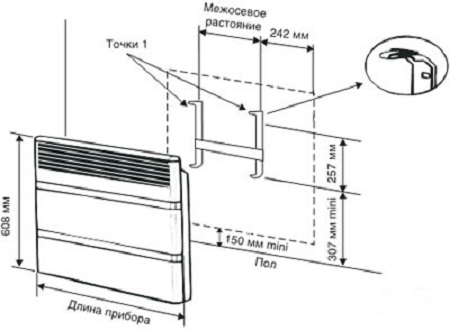
For heating non-residential premises any electric type convector with a mechanical thermostat or electronic control will do - everything will depend on the state of the family budget, how much money can be spent on heating a house in a village where no one lives permanently.
If you decide all the rooms in his apartment or to heat a private house with electric heaters, then you will need several wall convectors, which will be with fans inside - for faster heating of air in the rooms. They must be with electronic control units so that they can be connected to a programmer who will be engaged in adjusting the functioning of each product according to a specific program. Such adjustment will significantly reduce energy consumption in general.
The approximate installation of such equipment is shown in the photograph, but to do everything according to science - invite service center specialists. They will first make the necessary measurements of the voltage in the home network, establishwhether the sockets meet the requirements that will be imposed on them, and install convectors in the best place for high-quality space heating.
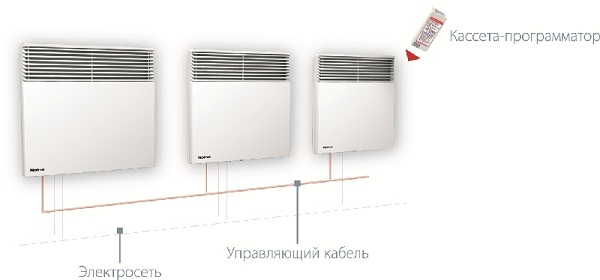
Advantages and disadvantages of equipment
All modern electric convectors, wall or floor layout have such qualities:
- do not require significant costs during operation;
- ease of installation;
- convenient control - mechanical or electronic;
- functional abilities comply with the requirements of ecology;
- safety of use.
All convectors are safe for children of any age: they have no sharp corners, the body does not heat up above +650C, therefore it is impossible to get burned.
With active work oxygen is not burned and the air in the room is not dried, as is the case with other heaters. Some models have autonomous power supply unit, ensuring the operation of the product during an emergency power outage. Buy a new temperature controller is not difficult, because its price is low.
There are no devices in the world that have only positive qualities - electric convectors are also no exception to the rule. The main disadvantage is the uneven heating of the entire room from floor to ceiling, especially at a ceiling height of 2.5–3 meters. In homes where there are unheated basements, it is felt immediately - a cooler airflow spreads across the floor.
Experts assure us that wall-type convectors are the most acceptable option for heating the living space for people. With the proper installation and adjustment of electronic automation, you will always feel comfortable, even when there will be fierce frosts outside the windows. Product power it is necessary to select for each room separately, taking into account its volume and heat loss. The standard is this ratio: 1000 watts per 10 square meters. m, the height of the ceiling at the same time - no more than 254 cm. All convectors are available in power up to 3.5 kW - they can be connected to public outlets.
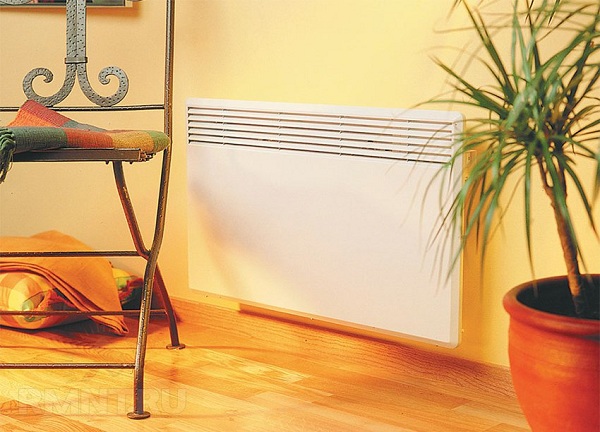
Popular manufacturers
It is very difficult for the user to make a choice when buying - there are so many heaters from manufacturers from around the world on the market that the head is spinning.Below is a list of the most well-known manufacturers, producing high-quality convectors heating and earned a good reputation.
- NOBO- a company from Norway, it is represented by a wide range of heaters in the form of panels. The temperature can be set optionally - a mechanical thermostat or an electronic automated unit. Developers pay close attention to protecting the voltage from fluctuations and long-term operation of the heat exchanger or heating element.
- NOIROT - A company from France, which in the early 1930s was founded by Jacques Noir. He has experience in creating different climatic equipment, because this year the company will celebrate 80 years from the date of the first electrical appliance. The model range is represented by convectors with any type of control and various body outlines.
- Zanussi- Today, this Italian company is considered to be a world famous manufacturer of various household appliances, and the founder of the dynasty, Antonio Zanussi, first glorified a private workshop in the distant 1916, when the staff of a young company was only a dozen people. Today, the company's engineers focus on the sought-after models ensuring their high durability.
- Electrolux- Swede Axel Wenner-Gren is considered to be the founder of the world-famous Electrolux concern; he invented the first European vacuum cleaner Lux 1, which weighed 13 kg, in 1912. Today, it is a well-known global brand of household appliances, from refrigerators to a different class of heaters, which are manufactured by the regional subsidiaries of the concern, so their characteristics are sometimes quite different from each other. The main advantage of all household equipment from Electrolux and electric wall convectors, including the very affordable price for all sectors of society.

/rating_off.png)






